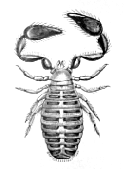
Consulting Entomologist

Tel/Fax: 01275 854224
E-Mail: [email protected]
Site Guide
Site Search
Home Page
Career Page
Insect Files
- Contents
- Bug Index
- The World of Bugs
- Classification of Bugs
- Insect Identification
- Insect Fossils
- Insect Body-parts
- Micro View of Bugs
- Insect Life Cycles
- Insect Defences
- Insects of Nailsea
- Pesticide Safety
- Bibliography
Shortcut to the main groups of insects and other arthropods...
Bug Rhymes & Poems
Links
Shop
Payments (credit/debit card)
False Scorpions |
Class: Arachnida Order: Pseudoscorpiones |
| Minature crab-like creatures around the house . . . . . . | |
 Chelifer sp. length up to 4 mm Chiridium sp. length up to 2 mm |
False Scorpions, also called Pseudoscorpions, are small arachnids (rarely more than 3-4 mm long), related to the true scorpions, spiders and mites. They resemble scorpions in having the terminal segments of the palps modified into relatively large pincers for catching prey, but they lack the stinging tail of true scorpions and are completely harmless. Their colouring is usually quite sombre in various shades of yellow and brown. Little is known of their mode of life, but most species live outside under stones, under loose tree bark, and in leaf litter, moss and other debris (the species of Chelifer shown top left is a typical example), but a few, such as Chiridium (shown bottom left), habitually live in houses and other buildings. Those found indoors, often among undisturbed books and papers, are perhaps the only species generally noticed and sometimes called 'book scorpions'. All species are carnivorous and probably feed on various tiny insects, worms and other small invertebrates. They generally walk fairly slowly, waving their pincers in front, but all can run swiftly backwards or sideways without turning, in a crab-like manner, if disturbed or threatened. Pseudoscorpions possess silk-glands opening on the chelicerae (or jaws), but do not spin snares or webs to catch prey like spiders. They appear to use these organs only to form silken retreats or 'nests' at the time of egg-laying or hibernation. Egg-laying females remain in these retreats throughout the whole period of egg development, during which time they nourish and incubate the eggs until their offspring emerge. Pseudoscorpions are most numerous in hot countries. Nevertheless, they are widely distributed and also found in colder regions. About seventy species of these curious, little arachnids are found in Europe, of which about twenty occur in Britain. |
|
An interesting observation from Wayne Huxtable (UK, 20/07/2006)...'I was looking at a false scorpion this morning in the kitchen. It looked exactly like the Chelifer sp., pictured on your helpful website. One interesting thing I witnessed about this creature was that it was attached to a common house fly, that we had swatted. I watched this creature with pinchers getting off the free ride, it was as if it knew that the fly was no longer in service(grounded)'. Evidently, this fascinating behaviour has been observed and recorded before, as noted in The Cambridge Natural History, Vol. IV, Crustacea & Arachnids (Macmillan London, 1909, p.430)...'one or two other species (of false scorpions) sometimes make themselves conspicuous by the remarkable habit of seizing hold of the legs of flies and being carried about with them in their flight'. | |
|
RELATED PAGES (Other Arachnida) | ||||
|
KING CRABS (Xiphosura) |
WHIP SCORPIONS (Pedipalpi) | |||
|
SCORPIONS (Scorpionidea) |
HARVESTMEN (Opiliones) |
MITES (Acari) |
WIND SCORPIONS (Solifuga) |
SPIDERS (Araneae) |
 (classification of arachnids) |
| <<< TOP | (use the back button on your web browser to return to the previous page) | TOP >>> |